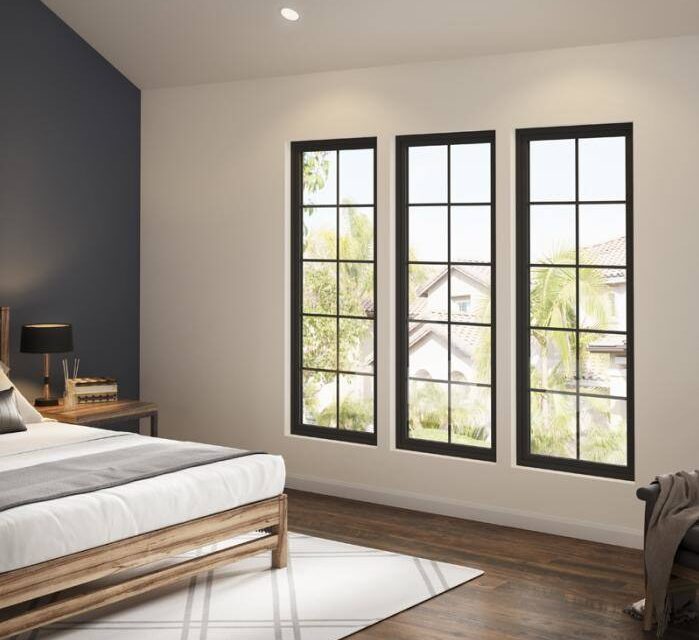If you have vinyl windows and want a fresh new look, you may be wondering if it’s possible to paint them. Vinyl windows have become increasingly popular due to their durability and low maintenance requirements. However, their color options may be limited, and some homeowners desire a different color or finish for their windows. This article will explore the feasibility of painting vinyl windows, the process involved, and the necessary steps to ensure a successful outcome.
Understanding Vinyl Windows
Vinyl windows are made from polyvinyl chloride (PVC), a versatile and sturdy material commonly used in construction. They offer several advantages over traditional window materials, such as wood or aluminum. Vinyl windows are known for their excellent energy efficiency, as they provide a tight seal that prevents drafts and keeps your home comfortable year-round. They are also resistant to rot, corrosion, and fading, making them an attractive option for homeowners.
The Composition of Vinyl Windows
Understanding the composition of vinyl windows is essential when considering painting them. The color of vinyl windows is typically infused during manufacturing, resulting in a long-lasting finish that doesn’t require painting. The color is embedded throughout the material, making it resistant to peeling, chipping, and fading. However, this also means that altering the color of vinyl windows can be challenging.
Regarding the composition of vinyl windows, it’s important to note that they are not solid PVC throughout. Instead, they consist of multiple layers contributing to their strength and durability. The outer layer, the capstock, protects the window from the elements. It is a weather-resistant material that helps prevent damage from UV rays, moisture, and other environmental factors.
Beneath the capstock is a layer of PVC material that provides structural integrity to the window. This layer is reinforced with additives to enhance its strength and resistance to impact. Finally, the innermost layer is made of PVC resin, which adds stability and insulation properties to the window.
The Pros and Cons of Vinyl Windows
Before delving into the process of painting vinyl windows, it’s essential to weigh the pros and cons of this decision. One of the main advantages of vinyl windows is their durability. They require minimal maintenance and are resistant to moisture damage, making them an excellent choice for high-humidity areas. Additionally, vinyl windows are often more affordable than other window materials, making them a cost-effective option for many homeowners.
Another advantage of vinyl windows is their versatility in design. They are available in various styles, including double-hung, casement, sliding, and more. This allows homeowners to choose the window style that best suits their aesthetic preferences and functional needs.
However, one downside of vinyl windows is their limited color options. While manufacturers offer a variety of standard colors, custom color choices may be limited or unavailable, leaving homeowners seeking alternative solutions, such as painting, to achieve their desired aesthetic.
Painting vinyl windows can be a viable option for those who want to change the color of their windows or refresh their appearance. However, it’s important to note that painting vinyl windows requires careful preparation and specific types of paint that adhere well to the material. Failure to follow the proper painting process can result in peeling, cracking, or other paint-related issues.
Before embarking on a painting project, consulting with professionals or doing thorough research is recommended to ensure the best outcome. Additionally, some manufacturers may have specific guidelines or restrictions when painting their vinyl windows, so checking the warranty and following any instructions is essential.
The Feasibility of Painting Vinyl Windows
While painting vinyl windows is possible, it’s important to consider the reasons behind this decision and the potential risks and challenges involved.
Why Consider Painting Vinyl Windows?
There can be several reasons why homeowners may wish to paint their vinyl windows. One common reason is to create a customized look that complements the overall aesthetic of their home. Painting can also be a cost-effective alternative to entirely replacing the windows, especially if they are in good condition.
Potential Risks and Challenges
Painting vinyl windows does come with certain risks and challenges. The most significant risk is the potential to void any existing warranties on your windows. Manufacturers typically do not recommend or support painting vinyl windows, and doing so may result in the loss of warranty coverage. It’s essential to weigh the aesthetic benefits against the potential loss of protection.
Another challenge when painting vinyl windows is ensuring proper adhesion. Vinyl has a smooth, non-porous surface that can make it difficult for paint to adhere effectively. The paint may peel, chip, or bubble over time without proper adhesion, requiring frequent touch-ups or complete repainting.
Preparing Vinyl Windows for Painting
If you decide to paint your vinyl windows, thorough preparation is key to a successful outcome. Properly preparing the surface will help the paint adhere effectively and ensure a long-lasting finish.
Cleaning and Prepping the Surface
The first step in preparing vinyl windows for painting is cleaning the surface. Remove any dirt, grime, or dust using a mild detergent and water mixture. Rinse the windows thoroughly and allow them to dry completely before proceeding. Removing any existing wax or silicone-based products is essential, as these can interfere with paint adhesion.
Next, lightly sand the surface using fine-grit sandpaper. This step helps create texture, allowing the paint to adhere better. Be careful not to sand too aggressively, which can damage the vinyl. After sanding, wipe away any dust with a clean, damp cloth.
Choosing the Right Paint
Selecting the appropriate paint is crucial for painting vinyl windows successfully. It’s essential to choose a high-quality exterior paint specifically formulated for use on vinyl surfaces. Look for excellent adhesion, flexibility, and UV protection paint products. Additionally, opt for lighter colors to minimize heat absorption, as darker colors can lead to warping and potential damage to the windows.
The Process of Painting Vinyl Windows
Now that the prep work is done let’s paint vinyl windows. Following a step-by-step guide will help ensure a smooth and professional-looking finish.
Step-by-Step Guide to Painting
1. Begin by applying a coat of high-quality primer designed for vinyl surfaces. This step enhances the adhesion of the paint to the windows and helps create a long-lasting finish.
2. Once the primer is dry, apply multiple thin coats of exterior paint. Use a brush or roller, depending on your preference and the size of the windows. Ensure each coat is dry before applying the next to avoid uneven or clumpy areas.
3. Apply the paint evenly, using long, smooth strokes. Avoid applying heavy coats, which can lead to unsightly drips or runs. Take your time and patience, allowing the paint to dry between coats.
4. Once you’re satisfied with the coverage, let the final coat dry completely before handling or reinstalling the windows. Follow the paint manufacturer’s recommended curing time to ensure the surface is fully hardened and damage-resistant.
Tips for a Smooth Finish
Here are a few additional tips to help you achieve a smooth and professional-looking finish when painting your vinyl windows:
- Cover adjacent surfaces, such as trim or glass, to prevent accidental paint splatter.
- Work in a well-ventilated area and wear appropriate protective gear, such as gloves and a mask.
- Consider painting during mild weather conditions to ensure optimal drying and curing.
- Avoid contact with water or cleaning products for at least a week after painting to allow the paint to cure fully.
Maintaining Painted Vinyl Windows
Once you’ve successfully painted your vinyl windows, proper maintenance is key to their longevity and appearance.
Cleaning and Care Tips
Regularly clean your painted vinyl windows using mild soap and water to keep your painted vinyl windows looking their best. Avoid using abrasive cleaners or harsh chemicals, which can damage the paint. Gently scrub the surface with a soft cloth or sponge and rinse thoroughly.
Inspect the paint periodically for any signs of wear or damage. If you notice chips or peeling, promptly address those areas by lightly sanding and touching up with matching paint. Proper maintenance and timely touch-ups will help extend the life of the paint and keep your windows looking fresh.
When to Repaint or Replace Vinyl Windows
Over time, the painted finish on vinyl windows may show signs of wear or fade. While vinyl windows are known for their durability, eventually, you may need to consider repainting or even replacing them. If the paint is extensively damaged, chipping, or peeling, it may be best to repaint the entire window. However, replacement windows should be considered if the underlying vinyl is significantly worn or damaged.
In conclusion, while painting vinyl windows is possible, it’s essential to consider the feasibility, potential risks, and necessary preparations. By following a step-by-step process and using the right materials, you can achieve a fresh new look for your vinyl windows. Remember to balance the aesthetic benefits against the potential loss of warranty coverage and ensure proper maintenance to preserve the finish for years.


